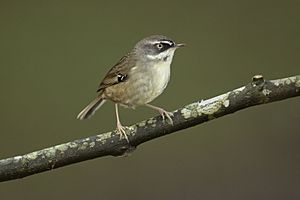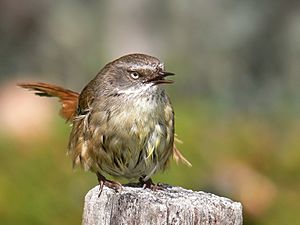White-browed scrubwren facts for kids
Quick facts for kids White-browed scrubwren |
|
|---|---|
 |
|
| Conservation status | |
| Scientific classification | |
| Genus: |
Sericornis
|
| Species: |
frontalis
|
The white-browed scrubwren (Sericornis frontalis) is a small passerine bird. You can find it along the coasts of Australia. This bird belongs to the Acanthizidae family.
It mainly eats insects. It likes to stay hidden in thick bushes. You might even find it close to towns. This bird is about 11 to 14 centimeters (4 to 5.5 inches) long. It is mostly brown. It has clear white "eyebrows" and light-colored eyes. There are a few types of this bird, and they look a bit different. White-browed scrubwrens live in small groups. They tend to stay in one area. They also help each other raise their young. The Tasmanian scrubwren used to be thought of as the same species.
Contents
About the White-browed Scrubwren
The white-browed scrubwren was first described in 1827. Two naturalists, Nicholas Aylward Vigors and Thomas Horsfield, named it. Its scientific name, frontalis, comes from a Latin word meaning "eyebrow."
Today, scientists divide this bird into two main types:
- S. f. frontalis: This is the white-browed scrubwren. It lives along the eastern coast of Australia. You can find it from the New South Wales-Queensland border down to Adelaide in South Australia.
- S. f. laevigaster: This type is called the buff-breasted scrubwren. It lives along the coast of Queensland. It is found from the New South Wales border up to the Atherton Tableland.
Another bird, the Tasmanian scrubwren (S. humilis), lives in Tasmania. It also lives on islands in the Bass Strait. It used to be considered a type of white-browed scrubwren. However, it is a bit bigger, about 13.5 cm long. It also lays larger eggs.
The spotted scrubwren (S. maculatus) is found in southern Australia. It lives from Kangaroo Island and Adelaide west to Shark Bay. Scientists studied its genes in 2018. They found it was different enough to be its own species. So, it was officially made a separate species in 2019.
What They Look Like
Most white-browed scrubwrens on the mainland are about 11.5 centimeters (4.5 inches) long. Their upper parts are olive-brown. They have bright, pale eyes and a clear white stripe above their eyes.
Their throat is white. The frontalis and laevigaster types have faint streaks on their throat. The maculatus type has many spots. The feathers covering their ears are grey in frontalis. They are black in laevigaster. Their underparts are light-colored. The laevigaster type has buff-colored underparts. Their thin beak is black.
Female birds are usually a bit duller in color. Males have darker patches near their eyes. This helps people tell them apart in nature. Their call is a loud, high-pitched sound like "ts-cheer."
Where They Live
These birds prefer forests or bushy areas. They like places with lots of thick plants on the ground. They rarely leave these hidden spots. They are common in bushland areas around cities like Sydney. White-browed scrubwrens do not migrate. They stay in the same place all year.
Behaviour
Scrubwrens mostly eat insects. They can be hard to see because they hide well. But they are very noisy, so you can often hear them. They live in small groups. These groups can have up to six birds.
They practice something called cooperative breeding. This means all the birds in the group help. They work together to feed and raise the young birds.
Reproduction and Life Cycle
The breeding season for these birds is usually from June or July to November or December. They build a nest that looks like a dome. It is made from dried grasses, leaves, sticks, and bark. They line it with feathers. The nest is placed on or near the ground. It is always hidden in thick plants.
A female scrubwren lays two or three eggs. The eggs are about 20 by 15 millimeters (0.8 by 0.6 inches). Their color can be brownish-violet to brownish-white. They often have darker spots. The Tasmanian scrubwren lays larger eggs. These eggs are about 23 by 17 millimeters (0.9 by 0.7 inches).
Images for kids
See also
 In Spanish: Sericornis de cejas blancas para niños
In Spanish: Sericornis de cejas blancas para niños




